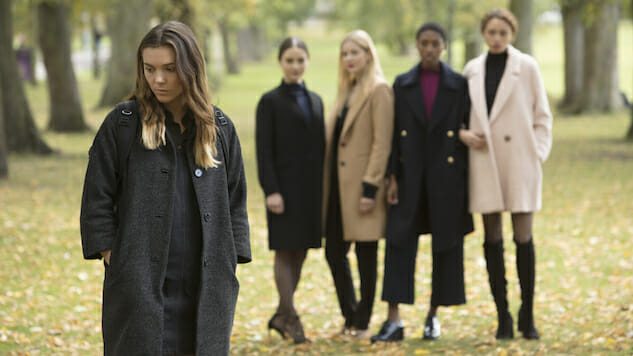European Imports Elite and Clique Update the “Dead Girl Show” for the Class War
Photo: Pop TV
Fairytales are weird, distilled expressions of our inherited desires, and the Dead Girl Show, and its idyllic, uncanny small-town setting, is absolutely in the same tradition. — Alice Bolin, “The Oldest Story: Toward a Theory of a Dead Girl Show”
Back when Pretty Little Liars was still promising to deliver on its bold misandrist fairy tale thesis, Alice Bolin wrote a gimlet-eyed essay for the Los Angeles Review of Books that juxtaposed the approaches to the Dead Girl Show taken by Twin Peaks and True Detective with that taken by Pretty Little Liars, and explored how shifting the storytelling lens away from adult men and toward still-living teen girls might allow the Dead Girl Show to evolve into something not “about a journey instigated by a Dead Girl body toward existential knowledge, but the mess, the calamity, and the obscurity that are the consequences of misogyny.”
Pretty Little Liars didn’t, ultimately, live up to this complex ideal, but the changes to the Dead Girl Show that it introduced—the transformation of the tiny, interconnected social worlds teens exist in to dreamy, dark fairy tale spaces; the refusal to offer a unified answer to the existential mystery the Dead Girl represents; the messy agency teen girls have in their own lives, even as the men in their orbit cajole and threaten—have established themselves so thoroughly as structural frameworks for the teen-oriented Dead Girl Shows that have taken Pretty Little Liars’ place since it went off the air that these new shows have been able to hone PLL’s anti-misogyny thesis, while also pushing the Dead Girl Show’s evolution in ever more progressive directions. A Dead Boy at the heart of a Dead Girl mystery? Riverdale is on it. The Dead Girl telling her own story to those left to try and make meaning out of it? 13 Reasons Why at least gave it a try. The Dead Girl and Dead Boy surviving their deaths to step instead into a kind of eldritch, hopeful power? Impulse and Cloak & Dagger are pulling it off!
The evolution doesn’t stop at American television’s borders: International markets are taking the lessons learned from three-plus decades of Dead Girl Shows and a decade and a half of Dead Girl teen shows and putting their own local spin on things—and I’m not just talking straight-up remakes, like the extra-sinister Turkish version of Pretty Little Liars, Tatl? Küçük Yalanc?lar, but also completely new, completely modern Dead Girl Shows primed for the digitally nomadic Gen-Z set. In October, Spain’s buzziest offering, Elite, hit the Netflix stream. This Wednesday, the UK’s slightly older-skewing project, Clique, premieres on Pop TV. Two European Dead Girl Shows, two (at least) Dead Girls (and/or Boys), two new directions for the form as meaningful narrative to go.
Of the two, Elite is the more familiar, at least in terms of teen TV. Set in a staggeringly elite private high school attended uniquely by the children of the 1%—as in, one of the main characters is literally a marchioness—Elite follows the changes to the social order as three students from a public school that collapsed on them while they were inside it are admitted on scholarship. Considering that one of the three scholarship students is a hijabi Muslim and that the father of two of the private school kids owns the construction company that built the school that collapsed, this would make for drama enough, but from the opening shot of one of the scholarship students drenched in blood and staring dead-eyed at the police shouting at and running toward him in dramatically slow motion, we also know that their entry into the one-percent’s orbit resulted in (at least one) murder. So far, so thrilling, and as long as you remember to switch your settings to Spanish [Original] audio with English subtitles, you’re in for a thoroughly calamitous, mostly compelling 10-hour binge.